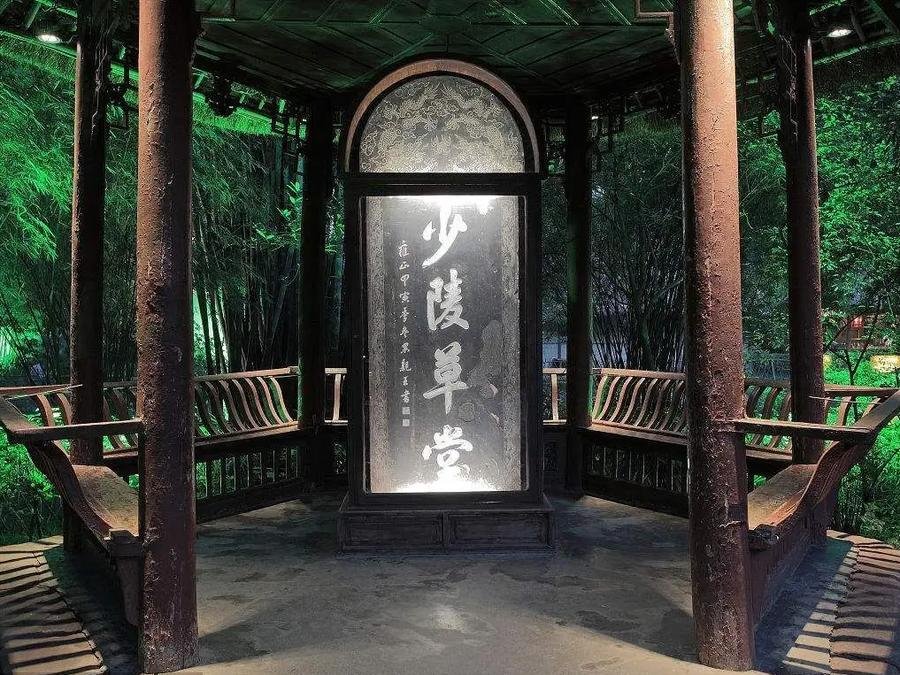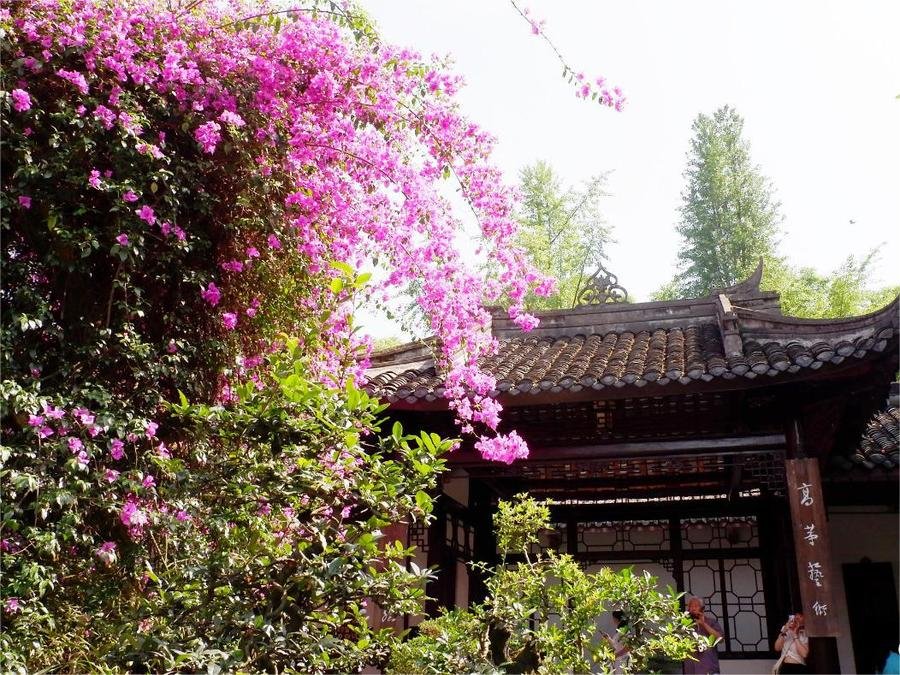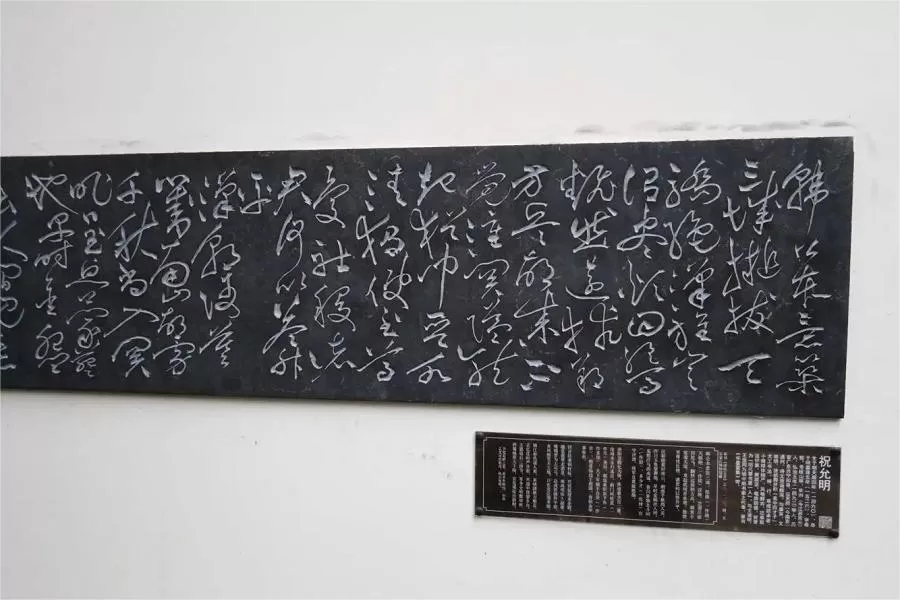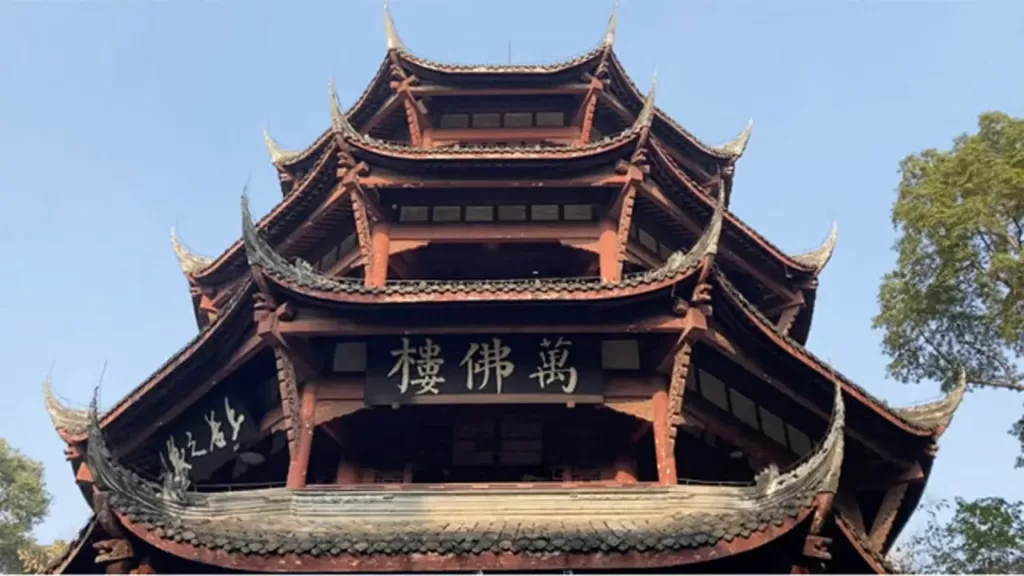Du Fu’s Thatched Cottage (杜甫草堂), located in Chengdu, China, is the former residence of the renowned Tang Dynasty poet, Du Fu. In the winter of 759 AD, Du Fu sought refuge in Chengdu to escape the turmoil of the An Lushan Rebellion, bringing his family along. With the assistance of friends, he constructed a thatched cottage by the picturesque waters of the Huanhua Creek in the western suburbs.
For nearly four years, Du Fu resided in this idyllic setting, where he produced more than 240 poems. Du Fu’s Thatched Cottage is revered as a “sacred place” in the history of Chinese literature. The tranquility of the surroundings and the poetic inspiration drawn from the landscape contributed to the creation of some of Du Fu’s most celebrated works.
The site’s historical significance was recognized by later poets and scholars. Over a century later, Wei Zhuang rediscovered the location of the thatched cottage and reconstructed it, ensuring its preservation. Subsequent dynasties, including the Song, Yuan, Ming, and Qing, undertook various renovations and expansions. The compound now spans nearly 20 hectares and maintains the original architectural layout from both the 1500 and the 1811 restoration.
The structures are arranged along a central axis, flanked by symmetrical corridors and other ancillary buildings. Throughout the expansive grounds, pavilions and towers dot the landscape, surrounded by ancient towering trees. Du Fu’s Thatched Cottage houses an impressive collection of over 30,000 volumes of various materials, providing a comprehensive glimpse into the poet’s life and times. Today, the site stands as a testament to the enduring legacy of Du Fu and his profound contributions to Chinese literature.
Table of Contents
- Basic Information
- Location and Transportation
- Highlights of Du Fu Thatched Cottage
- Map and Recommended Route
- Vlog about Du Fu Thatched Cottage
- Photography Spots and Tips
- History of Du Fu Thatched Cottage
- Useful Tips from Genuine Reviews
- Attractions Near Du Fu Thatched Cottage
Basic Information
| Website | https://www.cddfct.com/ |
| Estimated Length of Tour | 2 hours |
| Ticket Price | 50 RMB |
| Opening Hours | 9.00 – 18.00; Last admission: 17.00 |
| Telephone Number | 0086-028-87319258 0086-028-87345202 |
Location and Transportation
Du Fu Thatched Cottage is located in the western part of Chengdu, the capital city of Sichuan Province in southwestern China. The exact address is: No. 37, Caotang Road, Qingyang District, Chengdu, Sichuan Province, China. It is situated about 8 kilometers from the city center and can be easily reached by public transportation, including buses and metro.
Bus:
- Take bus 1024 and get off at Du Fu’s Thatched Cottage West Gate Stop (杜甫草堂西门站)
- Take bus 35, 58, 82, 151, 165, or 170 and get off Du Fu’s Thatched Cottage North Gate Stop (杜甫草堂北门站)
Subway:
- Take subway line 2, get off at Caotang North Road Station (草堂北路), and walk about 1 kilomters to the south to reach the north gate of the cottage.
Highlights of Du Fu Thatched Cottage
Ministry of Works Shrine

The Ministry of Works Shrine, known as the “Gongbu Shrine” (杜工部祠), derives its name from Du Fu’s position as a staff member in the Ministry of Works during his lifetime. The shrine features a single-room structure with three bays, adorned with imposing pillars, elevated stone steps, and decorative lattice windows and doors. Inside the shrine, visitors can find stone carvings of Du Fu dating back to both the Ming and Qing dynasties. Notably, the Ming Dynasty carving from the year 1602 represents one of the earliest surviving stone portraits of Du Fu within the cottage. Additionally, during the Qing Dynasty, the renowned poets Huang Tingjian and Lu You were enshrined alongside Du Fu, hence the alternative name “Three Sages Shrine.” The walls of the shrine also house exquisite stone carvings depicting the “Thatched Cottage of the Lesser Yangtze” (少陵草堂图), created during the reigns of the Qing Emperors Qianlong and Jiaqing. These detailed carvings served as a reference for the restoration of the cottage’s original appearance following the liberation period.
The Thatched Cottage Stele Pavilion

The Thatched Cottage Stele Pavilion (少陵草堂碑亭) stands as a representative structure within the cottage complex. This pavilion features a thatched roof and houses a stone stele inscribed with the characters “草堂” (Thatched Cottage), penned by Prince Guo Yunli during his visit to the cottage in 1734. Prince Guo Yunli, en route to Tibet to deliver gifts to the Dalai Lama, paid homage to the cottage and left this inscription as a testament to his reverence.
The Flower Path

The Flower Path (花径) serves as a scenic pathway connecting the commemorative buildings of the Du Fu Thatched Cottage with the original Thatched Cottage Temple. At the end of the flower path stands the “Thatched Cottage Screen Wall,” where the characters “草堂” are meticulously embedded in blue and white porcelain tiles. Despite several instances of damage and subsequent restoration, these characters remain a poignant symbol of the cottage. Chairman Mao Zedong, during his visit to the cottage in 1958, spent a prolonged moment gazing at these characters, underscoring their significance as a focal point for visitors seeking to capture the essence of the cottage through photography.
The Great Elegance Hall

The Great Elegance Hall (大雅堂), originally known as the main hall of the Thatched Cottage Temple, derives its name from the essay “Record of the Great Elegance Hall” by the Northern Song Dynasty literary figure Huang Tingjian. Adorning the entrance to the hall is a plaque bearing the characters “大雅堂” (Great Elegance Hall), penned by the renowned Tang Dynasty calligrapher Yan Zhenqing. Within the hall, visitors encounter the largest collection of large-scale colorful glazed murals and sculptures of twelve eminent poets from various dynasties, offering a visual narrative of Du Fu’s life and the evolution of classical Chinese poetry.
The Washing Flower Shrine

The Washing Flower Shrine (浣花祠), also known as the Jiguo Lady Shrine, lies east of the Poetry and History Hall. It comprises a central hall flanked by two side halls and features sculptures of the Jiguo Lady and her attendants. According to legend, after Du Fu left Chengdu, his residence was transformed into a villa for his wife, the Jiguo Lady (also known as the Washing Flower Lady). Upon her death, a shrine was established in her honor, and her likeness was commemorated with a painting. The shrine underwent several transformations before being rebuilt during the Qing Dynasty, preserving the legacy of the Jiguo Lady within the cottage complex.
Museum of Du Fu’s Life and Works

The museum at Du Fu Thatched Cottage is dedicated to the life and works of Du Fu, one of China’s most renowned poets. It features exhibits showcasing his calligraphy, poetry, and other literary works. Visitors can learn about Du Fu’s life, including his upbringing, education, and travels. The museum also displays various editions of his works, as well as artifacts related to his family and contemporaries. Interactive exhibits allow visitors to immerse themselves in Du Fu’s world, with multimedia presentations on his poems and the cultural context of his time.
Garden and Scenic Area

The garden and scenic area at Du Fu Thatched Cottage is a tranquil retreat in the heart of Chengdu. Visitors can stroll through the gardens, which include the Garden of Bamboo Shadows and the Plum Garden. The former features bamboo groves and a pond, while the latter is known for its beautiful plum blossoms in the spring. The natural surroundings and traditional Chinese architecture create a peaceful and serene atmosphere, offering visitors a glimpse into the beauty of ancient Chinese culture.
The Hall of Poetry and History

The Hall of Poetry and History stands as the main structure along the axis, representing the heart of the site. With over 1,400 poems left behind by Du Fu, this hall serves as a tribute to the renowned poet and his profound impact on Chinese literature. Du Fu’s poetry vividly portrays the social life of the Tang Dynasty before and during the An Lushan Rebellion, offering a glimpse into the historical transition from prosperity to decline. Revered as the “Poet Sage,” Du Fu’s works are often referred to as “poetic history,” hence the name “Hall of Poetry and History.” At the center of the hall sits a lifelike statue of Du Fu, crafted by the esteemed Chinese sculptor Liu Kaiqu, capturing the essence of the poet’s spirit.
The Tang-Style Pavilion

The Tang-style Pavilion is a striking feature of Du Fu Thatched Cottage. Located near the entrance of the site, it is a reconstruction of a traditional Tang Dynasty structure. Its elegant design and intricate decorations reflect the beauty of ancient Chinese architecture. The pavilion is an ideal spot for visitors to take photos and enjoy the scenery, with views of the garden and other pavilions in the distance. Its historical significance and artistic value make it an essential part of any visit to Du Fu Thatched Cottage
Map and Recommended Route

Entering and Exiting from the North Gate
- Route: North Gate → Water Pavilion (水榭) → Overview Pavilion (一览亭) → Grand Hall (大廨) → Poetic History Hall (诗史堂) → Rustic Gate (柴门) → Gongbu Temple (工部祠) → Thatched Cottage Scenic Area (茅屋景区) → Spring Night Rain Garden (春夜喜雨园) → Huanhua Temple (浣花祠) → Flower Path (花径) (Red Wall Path) → Grass Hall Screen Wall (草堂影壁) → Grand Elegant Hall (大雅堂) → Ten Thousand Buddhas Tower (万佛楼) → Admiring Pavilion (仰止堂) → Du Fu’s Thousand Poems Stele (杜甫千诗碑) → Orchid Garden (兰园) → Water Features (水系景点) → Tang Dynasty Ruins (唐代遗址) → North Gate
Entering from the South Gate and Exiting from the North Gate
- Route: South Gate → Main Entrance (West Gate) → Grand Hall (大廨) → Poetic History Hall (诗史堂) → The Sage’s Exhibition of Timeless Writings (诗圣著千秋展览) → Rustic Gate (柴门) → Gongbu Temple (工部祠) → Shaoling Cottage Stele (少陵草堂碑) → Thatched Cottage Residence (茅屋故居) → Flower Path (花径) → Grand Elegant Hall (大雅堂) → Affection for the Cottage (情系草堂) → South Gate
Entering from the West Gate and Exiting from the East Gate
- Route: Main Entrance (West Gate) → Grand Hall (大廨) → Poetic History Hall (诗史堂) → Rustic Gate (柴门) → Gongbu Temple (工部祠) → Thatched Cottage Scenic Area (茅屋景区) → Tang Dynasty Ruins (唐代遗址) → Thousand Poems Stele (千诗碑) → Flower Path (花径) (Best for Red Wall Photos) → Cultural Creative Museum (文创馆) (Stamp Collection Place) → Grass Hall Screen Wall (草堂影壁) (Great for photos of Chairman Mao’s silhouette) → Grand Elegant Hall (大雅堂) (Features Sculptures of 12 Great Poets and Literary Figures) → Optional visit to Ten Thousand Buddhas Tower (万佛楼) → Admiring Pavilion (仰止堂) → East Gate → Walk left to the North Gate of Huanhua Creek Park (浣花溪公园)
Vlog about Du Fu Thatched Cottage
Photography Spots and Tips
Water Pavilion at the North Gate
- Description: Entering through the North Gate, you’ll find a Water Pavilion (水榭) with a backdrop of a lotus pond.
- Tip: Capture the serene lotus flowers and leaves for a tranquil and picturesque shot.
Round Pavilion
- Description: Further inside, there is a traditional Round Pavilion (圆亭). It’s relatively quiet, offering a peaceful setting.
- Tip: Explore various angles to photograph the pavilion and the surrounding scenery.
Greenery by the Pond
- Description: The area around the pond features lush greenery.
- Tip: Even spontaneous shots can turn out beautifully here due to the natural and vibrant surroundings.
Grass Hall Screen Wall
- Description: Known as the “Grass Hall Screen Wall” (草堂影壁), this area features red walls and round arches along the Flower Path (花径).
- Tip: This spot is perfect for capturing artistic and contemplative photographs.
Pavilions and Corridors
- Description: The monastery is dotted with numerous pavilions and long corridors.
- Tip: Walk around and choose different pavilions or corridors for varied photo compositions.
Du Fu Museum Exterior
- Description: Outside the museum dedicated to the poet Du Fu, the red railings create an intriguing contrast with the natural surroundings.
- Tip: Photograph from a distance to capture the rustic charm and landscape.
Du Fu’s Poetry Gallery
- Description: Inside the gallery that features Du Fu’s poetry, you can find various exhibits including his poem “Thatched Cottage Destroyed by Autumn Wind” (茅屋为秋风所破歌).
- Tip: Stand beside your favorite poem for a personal and meaningful photo opportunity.
History of Du Fu Thatched Cottage
Du Fu Thatched Cottage (杜甫草堂) is a historic site in Chengdu, China, once home to the renowned Tang Dynasty poet Du Fu. The story of this literary landmark begins during a tumultuous period in Chinese history.
In the winter of 759 AD, Du Fu, fleeing the An Lushan Rebellion, arrived in Chengdu, Sichuan Province, with his family. This rebellion had ravaged much of China, prompting Du Fu to seek refuge far from the conflict. Upon arrival in Chengdu, Du Fu was initially sheltered by friends and supporters.
By the spring of 760 AD, with the assistance of local patrons, Du Fu was able to construct a modest thatched house on the picturesque banks of the Huanhua Creek, located on the western outskirts of Chengdu. This residence, known as “Chengdu Thatched Cottage” (成都草堂), became a haven for the poet. His famous poem, “On the Thatched Cottage of Chengdu” (《狂夫》), reflects his deep connection to this tranquil retreat, mentioning the location as “A thatched cottage west of the bridge, the waters of Hundred Flowers Pool are the same as the Yangtze” (万里桥西一草堂,百花潭水即沧浪).
Du Fu lived in the cottage for nearly four years, during which he was honored with the title of “Acting Assistant Minister of Works” (检校工部员外郎). His time at the cottage is marked by both personal and creative flourishing, contributing significantly to his body of work. Due to his government position, he was often referred to as Du Gongbu (杜工部), a testament to his official role.
In 765 AD, Du Fu faced further personal hardship with the death of his patron, Yan Wu. This loss forced him to leave Chengdu with his family, and he continued his wanderings through the Three Gorges region, eventually ending up in Hunan and Hubei provinces. After Du Fu’s departure, the thatched cottage fell into disrepair.
During the Five Dynasties period (907-960 AD), the poet Wei Zhuang rediscovered the ruins of the cottage and had it rebuilt to honor Du Fu’s memory. The reconstruction aimed to preserve the site and commemorate the poet’s significant contributions.
The site was further renovated during the Song Dynasty (960-1279 AD), and portraits of Du Fu were painted on the walls, transforming the cottage into a memorial. Despite subsequent periods of neglect and damage, including destruction during the Ming Dynasty (1368-1644) and the late Qing Dynasty (1644-1912), major renovations in 1500 and 1811 helped establish the scale and layout of the current site.
The late Qing Dynasty saw multiple reconstructions under the reigns of Emperors Kangxi, Yongzheng, Qianlong, and Jiaqing. However, during the Republic of China era (1912-1949), the site suffered considerable damage due to warfare and misuse, with parts of the structure being repurposed or destroyed.
In 1952, Du Fu Thatched Cottage underwent comprehensive restoration and was officially opened to the public. Today, it stands as a well-preserved memorial, honoring the legacy of one of China’s greatest poets and offering visitors a glimpse into the tranquil environment that inspired his timeless works.
Useful Tips from Genuine Reviews
Entrances: The museum has three entrances: North, South, and West. The North entrance houses the visitor center and serves as the entry to the Plum Garden. The South entrance is crowded, mainly used by tourist groups. The West entrance, though the smallest, is the true main entrance to Du Fu Thatched Cottage. It’s recommended for fewer crowds and easy access to the core architectural area along the central axis. North exit offers dining options and convenient access to the Sichuan Museum.
Parking: There are professional underground parking lots outside both the North and South main gates.
Summer Tip: Expect more mosquitoes in the summer. It’s suggested to bring mosquito repellent like floral water. Adjacent to the cottage, there’s a large pond with fat koi fish. Visitors can buy fish food at the site for 2 yuan per pack.
Afternoon Visits: For afternoon visits to Du Fu Thatched Cottage, it’s recommended to experience the nearby “Fuyin Night Market” to sense the vibrant Chengdu nightlife.
Highlighted Recommendation – Da Ya Tang: Highly recommended is the Da Ya Tang, named by Huang Tingjian, featuring large depictions of Du Fu’s tumultuous life stages accompanied by verses from his poems. Additionally, there are introductions to over ten predecessors and successors of Du Fu, including Qu Yuan, Su Shi, among others.






